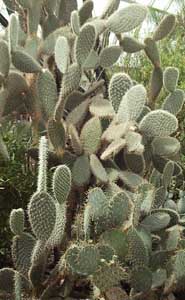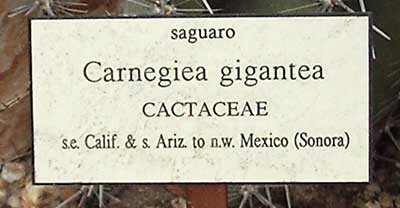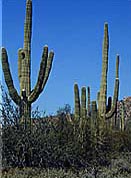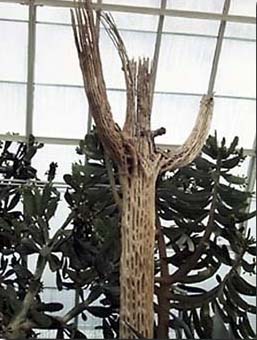| Cactaceae | Propagation | Bibliography | NYBG virtual herbarium (Cactaceae) |

This is an Opuntia cactus,
one of the most common.
CACTACEAE- Carnegiea
gigantea
This species of Cactaceae was originally discovered by George Engelmann in 1848.
Engelmann called this cactus Cereus giganteus, because of its huge size.
Later, in 1908, it was renamed by Britton and Rose. They changed the name to
Carnegiea gigantea to honor the world renowned industrialist Andrew Carnegie.
This cactus, which is only found in the United States, grows in Arizona, southeastern
California and in Sonora, Mexico. It is the largest cactus in the United States.
This cactus can reach a height of 60 feet and can weigh up to two tons. The
Carnegiea gigantea takes about 150 years to grow to its full size. Fruits
and flowers appear on the Carnegiea gigantea in the late spring when
the cactus is about 40 years old.
These cacti, along with all others, can live for so long in such dry areas because
they fill their stems with water and store it for long periods of time. They
are able to retain this water because their leaves have been reduced to spines,
therefore reducing the surface area for transpiration to occur. Cacti are classified
as succulents based on this water retaining characteristic.

|

|

|

|
|
Carnegiea gigantea is too young to have grown any branches yet |
New York Botanical Garden Conservatory |
of a living Carngiea gigantea growing in its natural habitat |
is dead. However you can still see the different branches coming off of the main stem. The shape of this is a good comparison to the image of a young cactus on the far left. |
There are many types of propagation commonly used to reproduce cacti. Certain techniques of propagation are recommended over others for their speed or success. Propagation of cacti is a very easy and rewarding way of growing new plants. Propagation is also the only legal way to acquire new plants of endangered or rare species. Two of the fastest techniques used in propagation that produce the quickest results are taking cuttings and dividing a plant. Growing a plant from seed takes more time, but opens up the possibility of cultivating new forms of the plant. Another method of propagation, known as grafting, is very time consuming and is typically used for plants that require high temperatures or are slow growing. Grafting will allow these plants reach maturity in only a few years.
Methods of Cacti Propagation
GROWING A PLANT FROM A SEED
This technique is one that requires some time. For best results, it is recommended that fresh seeds be used as opposed to seeds from a packet. Once the fresh seeds have been collected and dried thoroughly, they can be dispensed evenly over a pot containing cactus potting mix. It is not necessary to dig holes for the seeds. Moisten the potting mix thoroughly with warm water. Finally, cover the surface with grit and place the pot in either a plastic bag or a propagation bag.
After about 2-4 weeks, the seed should have germinated and the pot can be taken out of the bag. Place the pot in a bright location. Do not leave it in a location that gets direct sunlight as the sun may scorch the young cactus.TAKING CUTTINGS
Taking cuttings is an easy way to propagate hybrids, since hybrids do not produce like plants when grown from seeds. It is also an effective method for other cacti. The most effective cutting techniques are taking stem cuttings or stem sections.
To grow a cactus from a stem cutting you must pick a stem from the original cactus and then cut the stem straight across above a shoot so that you do not leave a stub. Trim the stem so that the cutting is approximately 2-4 inches long. The cutting must then be left alone for a few days to a couple weeks until a callus is formed over the cut edge. It is not until the callus has been formed that the stem will be ready for planting. When the stem is ready to be planted, fill the pot one third full with cactus potting mix, cover the mix with small washed grit, and place the cutting in the middle of the pot .It should take about two to six weeks for the cutting to form a root.
To grow a cactus from stem sections is a bit different. First you must cut a flat stem to a suitable length. A stem which is more like a column should be cut at a point in proportion to its diameter. These cuttings must also then be left alone until a callus forms over the edge which has been cut. Use the smallest pot that can hold the section without it falling over. Fill the pot one third full with cactus potting mix, a thin layer of grit, and place the cutting in the pot without putting it too far in to the mix. Leave to grow.
DIVIDING
In the division method, a plant is divided into several sections, each of which has its own roots. When dividing, it is necessary to have individual pots for all of the different sections removed from the original. Once the sections are separated from the original, you may plant them in their own pot and leave them to grow.GRAFTING
The method of grafting two cacti together is a very time consuming process and typically results in a cactus that is extremely unattractive. Grafting is best used when it is almost impossible for a cactus to be reproduced any other way.
Grafting cacti was once a very rare occurrence, it was typically used when the habitat of a cactus was difficult to simulate. Now this technique has become much more popular and many of the cacti sold in stores are propogated this way. Grafting is popular technique because a plant that has been grafted can grow to be the same size as a four or five year old non-grafted cactus in just one year. When grafting two cacti together it is essential to have two healthy plants. The stock of the cactus should generally be stronger than the top part (scion) because the cactus will grow much faster. The next step is to make sure that the scion and the stock have the same diameter and have extremely smooth horizontal cuts. The two pieces are then rubbed together and gently pressed to get rid of any air bubbles. In order to get the graft to "hold" securely the cuts must be perfect and the scion must be able to fit tightly on the stock without to much effort. The two pieces are then held together by a rubber band which is stretched from the bottom of the flower pot up to the top of the cactus. These two pieces should fuse in about a month if they are kept at the appropriate temperature.
IMAGES:
Most taken in The New York Botanical Garden Conservatory by Caroline Safran.
The grown Carnegiea Gigantea:
http://www.desertusa.com
BOOKS CONSULTED:
Hewlett, Terry. 1997. The Complete book of Cacti & Succulents. DK Publishing, Inc., New York.
Pizzetti, Mariella. 1985. Simon & Schusterís Guide to Cacti and Succulents. Simon and Schuster Inc. New York.